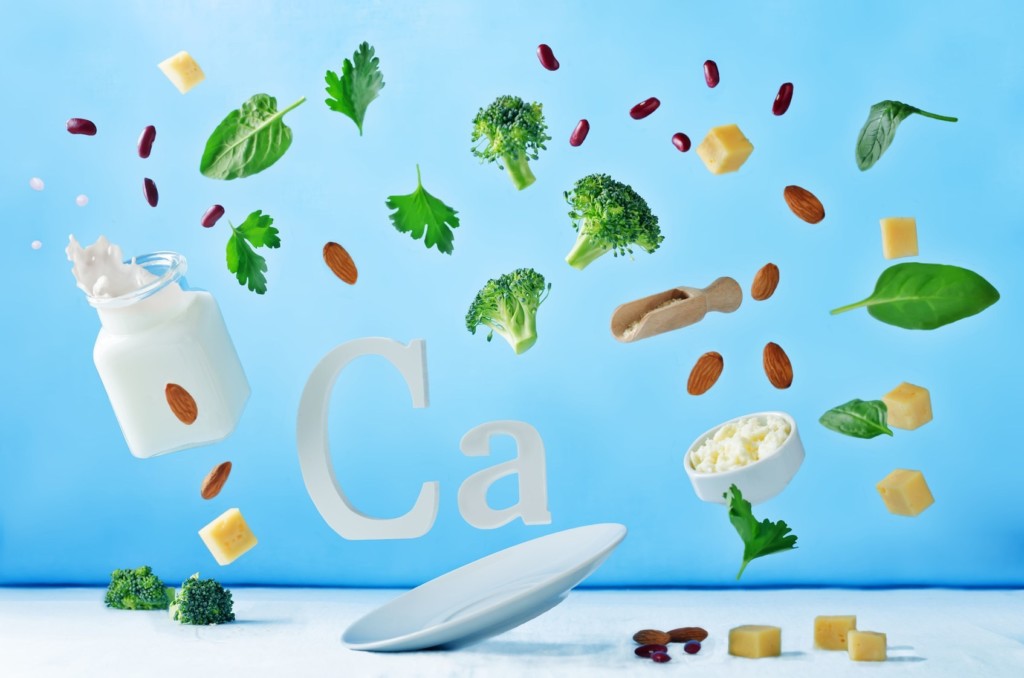2% of our body weight is calcium. Calcium is particularly abundant in our teeth and bones. This salt mineral symbol Ca, is essential for the proper functioning of our bones, as well as our body's vital functions.
Table of contents
HideHow to choose the right calcium? In what proportions? How to avoid calcium deficiency?
Find out more about this mineral in this guide.

What do I need to know about calcium?
Everyone needs calcium. In adulthood, our body contains about 1 kg of calcium. This mineral salt is essential for bone constitution. But it is also involved in regulation of blood coagulation, nerve impulses and muscle contraction.

Why do I need calcium every day?
To grow well, we need calcium. And this is true from the moment a foetus is formed in the womb. In fact, bone is a living tissue that renews and deteriorates throughout our existence. Old bone permanently gives way to young boneThis is particularly true when the bone is repairing major damage. In adulthood, 4% of bone is renewed every year, including after the menopause. Before puberty, it renews itself at a rate of 20% per year.
This content is part of the guide Blooness, the guide to the ideal human diet, the summary of which you can find here 🌱🥑
It is therefore important to eat enough calcium every day to stay healthy and, above all, to grow well at every stage of our lives. Although human skeletal growth generally ends at the age of 18, bone tissue continues to thicken until the age of 19, 20 or 25.

As we reach our thirties, our bones begin to age, and we notice a significant drop in the quantity of young bone. And things accelerate from the age of 50 or 60 onwards, depending on gender, leading to the development of osteoporosis in both men and women.
French-speaking subscribers will receive the newsletter in French, and all others will receive an English version.
Long before we realize that our bodies are deficient in calcium, it's essential to ensure that we have sufficient quantities at all ages.
What role does calcium play in my body?
99% of the calcium present in our body is concentrated in our bones to ensure their solidity and hardness (skeleton, teeth). Calcium is essential for bone growth in children and adolescents. In young adults, it helps maintain bone capital, and in senior citizens, it prevents osteoporosis and high blood pressure.
Muscle contraction, blood clotting, nerve conduction, hormone release, cell division and the activation of certain enzymes are also ensured by extraosseous calcium.
The beneficial effects of calcium depend, however, on the presence of other essential nutrients such as proteinsthe vitamin D, fluorine and phosphorus.

Recommended nutritional intake
|
Age/State |
Nutritional reference in mg/day |
|
Children aged 1 to 3 |
500 |
|
Children aged 4 to 6 |
700 |
|
Children aged 7 to 9 |
900 |
|
Teens aged 10 to 19 |
1200 |
|
Adults |
1,000 up to age 24 and 950 thereafter |
|
Pregnant women (3ème quarter) |
1000 |
|
Nursing mothers |
1000 |
| Seniors (men over 65 and women over 55) |
1200 |
What foods can I find calcium in?
Milk and dairy products (yoghurts, cheeses, etc.) are the most famous foods for their daily calcium intake. The rest is generally covered by a diet rich in calcium. vegetables green leafy vegetables, mineral water, dried fruit and pulses.
However, it's best to forget milk and yoghurt, which are not recommended in this guide, and opt instead for cheese, ideally goat's or sheep's, and preferably in the morning, in order to respect the human biological rhythm, as advocated by the principle of chrononutrition, to which we'll return later.
To take an example, we could supplement the cheese in the morning with almonds for a snack, and cabbage and sardines in the evening.

The foods richest in calcium
|
Food |
Calcium content in mg/100g |
|
Parmesan cheese |
1200 |
|
Cantal - Comté |
970 - 880 |
|
Sardines in oil, drained |
613 à 798 |
|
Saint Paulin, Gouda, Morbier, Edam |
705 à 793 |
|
Blue cheeses |
443 à 600 |
|
Carré de l'Est, Coulommiers, Camembert |
450 à 490 |
|
Anchovies in oil, drained |
296 |
|
Almonds |
248 |
|
Chervil - Parsley |
260 – 200 |
|
Cooked pink shrimp |
225 |
|
Sheep's milk |
187 |
|
Dried fig |
167 |
|
Plain whole milk yogurt |
167 |
| Dandelion - Watercress |
165–157 |
|
Goat's cheese crottin |
139 à 151 |
| Plain semi-skimmed or skimmed milk yoghurt |
146 à 149 |
|
Cooked spinach |
141 |
| Egg yolk |
137 |
|
Pistachio |
135 |
| Cooked winkle |
130 |
|
Fromage blanc, whole or skimmed milk |
120 à 125 |
| Cow's milk |
120 |
|
Semi-skimmed milk |
114 |
| Black radish - Raw spinach |
105 |
|
Broccoli - Oyster - Swiss chard - Kidney bean - Black olive - White bean - Blackcurrant |
93 – 92 – 80 – 66 – 61 – 60 – 60 |
| Cooked celery, cooked broccoli, cooked green beans, cooked kale |
53 à 59 |
|
Contrex, Courmayeur or Hépar mineral waters |
48 to 58/10cl |
| Blackberry, orange |
39 |

When is additional calcium recommended?
In cases of proven calcium deficiency, an intake of 500 to 1500mg/day is prescribed, depending on the individual's age.
A calcium supplement is also indicated in the prevention of :
- Osteoporosis
- Obesity and overweight
- Pre-eclampsia in pregnancy
- Preventing colon or colorectal cancer

The case of osteoporosis
Osteoporosis is due to an imbalance between the action of osteoclasts, the cells that destroy bone, and osteoblasts, which rebuild it. It has two possible origins:
- A primitive origin. For example, prolonged bed rest, early menopause, late menstruation, smoking or alcohol consumption, genetic reasons, etc...
- A secondary cause. For example a lack of vitamin D, hypothyroidism or hyperthyroidism, rheumatoid arthritis, etc...
Interaction with other minerals
Other means of prevention appear to be effective in reducing the risk of osteoporosis. These include physical activity and adequate vitamin D intake to promote intestinal absorption of calcium. It is also essential to ensure an optimal supply of magnesium and proteins to promote calcium absorption.
In addition, a high level of phytic acid (cereals (wholemeal, dried beans, wheat bran, soya), oxalic acid (spinach, cocoa, sorrel, beet), as well as certain fruit pectins, reduces calcium assimilation. Similarly, high levels of protein, sulphates and salt in the diet also promote calcium elimination through urine.
Conversely, an excess of calcium can reduce the assimilation of other nutrients. minerals such as zincmagnesium and iron. Calcium supplements also reduce the assimilation of certain drugs such as bisphosphonates (osteoporosis treatment), thyroid hormones, cyclins (antibiotics), strontium (osteoporosis treatment), estramutin (prostate cancer treatment), as well as iron and zinc supplements.
Simultaneous use of calcium salts and digoxin is prohibited, as it increases the risk of cardiac rhythm disorders. Similarly, simultaneous use of calcium supplements and thiazide diuretics can lead to hypercalcemia.

Deficiency and overdose: what am I at risk of?
Rickets in children and osteoporosis in adults are the most obvious signs of long-term calcium deficiency.. In addition to these two manifestations, fractures of the wrist and hip (or neck of the femur) can also occur, as can vertebral compression. Much more common in women than men, the disease generally manifests itself between the ages of 30 and 80.
Calcium deficiency can also lead to skeletal and joint deformitiesmuscle and abdominal cramps, bone pain, tingling in the fingertipsThese can lead to a wide range of symptoms, including tetany, memory problems, nervousness and irritability, respiratory problems and even headaches.
Excess calcium is generally harmless, as this mineral is automatically eliminated through stool, sweat, urine and milk in breast-feeding women. Be careful, however, as a sensitive person may run the risk of kidney stones if they take in too much calcium (up to 2g/day)...
Next chapter: the magnesium.
Previous chapter: introduction to minerals.

